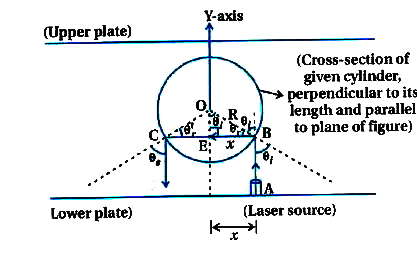Complete Solutions to SECTION-C (NCERT EXEMPLAR SOLUTION) (LONG ANSWER TYPE QUESITONS) of chapter RAY OPTICS AND OPTICAL INSTRUMENTS of Class 12 book with complete answers and questions
| Class 12 | PHYSICS |
| Chapter | RAY OPTICS AND OPTICAL INSTRUMENTS |
| KUMAR PRAKASHAN | SECTION-C (NCERT EXEMPLAR SOLUTION) (LONG ANSWER TYPE QUESITONS) |
| Number Of Questions | 5 |
| Academic Year | 2023-24 |
Show that for a material with refractive index `mu ge sqrt(2)`~ , light incident at any angle shall be guided along a length perpendicular to the incident face.
View SolutionThe mixture a pure liquid and a solution in long vertical column (i.e, horizontal dimensions `lt lt` vertical dimensions ) Produce diffusion of solute particles and hence refractive index gradient along the vertical dimesion . A ray of light entering the column I at right angles to the vertical is deviated from its original path. Find the deviated from its original path. Find the deviation in travelling a horizontal distance `d lt lt `h, the height of the coloumn.

View SolutionIf light passes near a massive object, the gravitational interation causes a bending of the ray. This can be thought of as heappening due to a change in the effective refrative index of the medium given by
`n(r) =1 +2 GM//rc^2`
where r is the distance of the point of consideration from the centre of the mass of the massive body, G is the universal gravitational constant, M the mass of the body and c the speed of light in vacuum.
Considering a spherical object find the deviation of the ray form the original path as it graxes the object.
View SolutionAn infinitely long cylinder of radius R is made of an unusual exotic material with refractive index-1 (see figure). The cyliner is palced between two planes whose normals are along the y- direction . The center of the cylinder O lies along the y - axis . A narrow laser beam is directed along the y direction from the lower plate. The laser source is at a horizontal distance x from the diameter in the y - direction.
Find the range of x such that light emitted from the lower plane does not reach the upper plane.

View Solution
Consider a thin lens placed between a source (S) and an observer (O) (see figure) . Let the thicknes of the lens very as `w(b) = w_0 - (b^2)/(alpha)`,
where b is the verticle distance from the pole.
`w_0` is constant. Using Fermat.s principle i.e. the time of transit for a ray between the source and observer is an extremum, find the condition that all paraxial rays starting from the source will converage at a point O on the axis. Find the focal length.
(ii) A gravitational lens may be assumed to have a varying width of the from
`w(b) = k_1 "ln" ((k_2)/(b)) b_("min") lt b lt b_("max")`
`= k_1 "ln" ((k_2)/(b_"min")) b lt b_("min")`
Show that an observe will see an image of a point object as a right about the center of the lens with and angular radius
`beta=sqrt(((n-1)k_1(u)/(v))/(u+v))`
View Solution
SECTION-C (NCERT EXEMPLAR SOLUTION) (LONG ANSWER TYPE QUESITONS) questions and complete solutions for chapter RAY OPTICS AND OPTICAL INSTRUMENTS of KUMAR PRAKASHAN KENDRA PHYSICS (GUJRATI ENGLISH) of Class 12
All Exercises from KUMAR PRAKASHAN Class 12 PHYSICS RAY OPTICS AND OPTICAL INSTRUMENTS
- SECTION - A (QUESTIONS - ANSWERS)
- SECTION - A (TRY YOURSELF)
- SECTION-B (NUMERICALS)(NUMERICAL FROM .DARPAN. BASED ON TEXTBOOK )
- SECTION-B (NUMERICALS)(NUMERICAL FROM TEXTUAL EXERCISE)
- SECTION-B (NUMERICALS)(NUMERICAL FROM TEXTUAL ILLUSTRATIONS)
- SECTION-C (NCERT EXEMPLAR SOLUTION) (LONG ANSWER TYPE QUESITONS)
- SECTION-C (NCERT EXEMPLAR SOLUTION) (MULTIPLE CHOICE QUESTIONS (MCQs))
- SECTION-C (NCERT EXEMPLAR SOLUTION) (SHORT ANSWER TYPE QUESITONS)
- SECTION-C (NCERT EXEMPLAR SOLUTION) (VERY SHORT ANSWER TYPE QUESITONS)
- SECTION-D (MULTIPLE CHOICE QUESTIONS (MCQs))(MCQs ASKED IN COMPETITIVE EXAMS)
- SECTION-D (MULTIPLE CHOICE QUESTIONS (MCQs))(MCQs FROM .DARPAN. BASED ON TEXTBOOK)
- SECTION-D (MULTIPLE CHOICE QUESTIONS (MCQs))(MCQs FROM .DARPAN. BASED ON TEXTBOOK)(MCQs BASED ON TEXTUAL ILLUSTRATION AND EXERCISE)
- SECTION-D (MULTIPLE CHOICE QUESTIONS (MCQs))(MCQs FROM .DARPAN. BASED ON TEXTBOOK)(NATURAL PHENOMENA DUE TO SUN LIGHT )
- SECTION-D (MULTIPLE CHOICE QUESTIONS (MCQs))(MCQs FROM .DARPAN. BASED ON TEXTBOOK)(OPTICAL INSTRUMENTS)
- SECTION-D (MULTIPLE CHOICE QUESTIONS (MCQs))(MCQs FROM .DARPAN. BASED ON TEXTBOOK)(REFRACTION AND DISPOSION BY PRISM)
- SECTION-D (MULTIPLE CHOICE QUESTIONS (MCQs))(MCQs FROM .DARPAN. BASED ON TEXTBOOK)(REFRACTION)
- SECTION-D (MULTIPLE CHOICE QUESTIONS (MCQs))(MCQs FROM .DARPAN. BASED ON TEXTBOOK)(REFRACTION, MAGNIFICATION, POWER AND COMBINATION OF LENS)
- SECTION-D (MULTIPLE CHOICE QUESTIONS (MCQs))(MCQs FROM .DARPAN. BASED ON TEXTBOOK)(TOTAL INTERNAL REFLECTION)